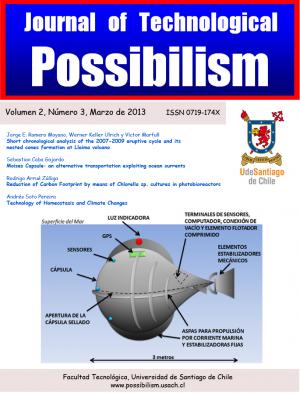Nº 3, Marzo 2013
Short chronological analysis of the 2007-2009 eruptive cycle and its nested cones formation at Llaima volcano - Jorge Romero M., Werner Keller U. y Víctor Marfull - Download
- Abstract. The Llaima volcano (38°41’S / 71°43′W) is one of the most active volcanoes of
South America. In the present work we have combined direct field and sequential
photography observation plus remote sensing of low cost, making possible to reconstruct
its 2007-2009 eruptive cycle. Llaima volcano eruption began on January 1, 2008 at 18:11
local time, preceded by seismic and surface precursory activity. The onset of eruptive
activity was followed by a second paroxysmal eruption occurred on April 2009, and the
occurrence of Hawaiian, strombolian and phreatomagmatic reactivation pulses which
edified a series of small nested scoriae and spatter cones inside the main crater of
volcano. Their evolution was widely registered, defining with clarity two eruptive stages
and nine eruptive phases. Several basaltic pahoehoe and AA lava flows descended from
the main crater, producing glaciers melting and then lahars, which transported large-size
blocks of ice and boulders. Also, pyroclastic flows and ash fall events where observed.
This activity persisted until 2009 when finally ended. The record is very important to learn
about Llaima eruptive behavior and could be used in population risk management.
- Keywords: Llaima, 2007-2009 eruptions, remote observation, Southern Andes, Chile.
Moises Capsule: an alternative transportation exploiting ocean currents - Sebastián Caba G. - Download
- Abstract: The South American territory of Chile is characterized by its narrowness and length
totaling more than 6435 kilometers of coastline. Ground transportation along this strip of land
is mostly done by a monopoly road, with conspicuous absence of railway alternatives to the
north. Therefore, the use of these land routes increases both private and social costs. Tolls,
deteriorating pavement folders, traffic jams, and carbon footprint are some costs incurred in
land transport. However, parallel to the country, along the coasts the Humboldt Current flows,
which due to its regularity can serve as a conveyor belt. Considering this natural way, the
project proposes to send goods left over in the south to the north where they are in deficit.
Indeed, even when the speed of the current is slow, scheduled shipments water and other
forestry and agricultural goods to the north can be an attractive solution. This non-motorized
transport northward implies three challenges: 1) characterizing the Humboldt Current with its
spatio-temporal variability, 2) automated devices for channeling ships and 3) materiality of the
vessels that once made transport, they themselves can be used for other purposes.
- Keywords: transport, alternative, ocean current, natural belt, automated ships.
Reduction of Carbon Footprint by means of Chlorella sp. cultures in photobioreactors - Rodrigo Arrué Z. - Download
- Abstract. The high levels of greenhouse gases in the atmosphere and the changes caused
on the environment make impresindible develop tools that improve the sustainability of human
activities. The new greenvertising in several markets and growing environmental concern
makes quite attractive to develop tools to reduce the environmental impact of business
operations without reducing production level or quality. Microalgae´s cultures are bloody
efficient CO2 sequestration. These crops when are performed into bioreactors, they greatly
improves the culture conditions being controlled and more effective. Two types of companies
were modeling by means of microalgal production: a vineyard and agribusiness enterprise
where emissions were used by the companies for the 2012. Finally it takes 15 and 18
photobioreactors respectively, which was designed with a volumetric capacity of 13 [m3] with a
proposal absorbing 80% of the contaminant load. Once stabilized the culture system, you can
perform the audits to certify Carbon Footprint later to make branding strategies business.
- Keywords: greenhouse gases, carbon footprint, microalgae, photobioreactor, sustainability.
Technology of Homeostasis and Climate Changes - Andrés Soto P. - Download
- Abstract: Climate changes have accompanied Man throughout his history. Moreover, the
human species is an evolutionary result of various climate changes. While widespread
concern relates to attack the causes, this paper discusses how to adapt to them, highlighting
the benefit that can be achieved to environmental changes. Possibilism, Biotechnology and
Communication Technologies, seem to be the most appropriate means in an environment
where not only there will be losers, but also multiple winners.
- Keywords: Homeostasis, Climate Change, Possibilism, Biotechnology, Communication.

